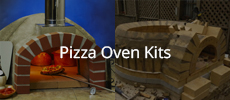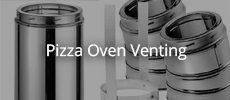Announcement
Collapse
No announcement yet.
32" Homebrew Cast, Metal Stand - Dallas, TX
Collapse
X
-
It looks like you’ve not designed your flue gallery for an anchor plate fitting. If you intend fitting a flue pipe to the inside of the casting, ensure it is a slightly loose fit or its expansion could crack your casting. If fitting it outside the casting this is not a concern.
-
Ceramic Fiber Blanket
I used 4" of ceramic fiber blanket on the dome, and 2" over the gallery. I cut a template to cut periodic slits with a long knife. This allowed it to pretty effectively wrap around the dome. Repeated with the second layer of 2" blanket.5 Photos
Leave a comment:
-
Gallery de-molding & touch-ups
I definitely should have hollowed out a portion of the foam mold. It was an absolute bear to remove. I use a large drill bit, hot wire, and screw driver to eventually chip away at it.
I used a slurry coat to touch up the various voids in the casting.6 PhotosLast edited by loganc10; 02-18-2023, 06:09 PM.
Leave a comment:
-
Building gallery foam mold
I used 1" foam sheets and laser cut cross sectional slices of my gallery design.
I glued the slices together, then covered in packing tape.
4 Photos
Leave a comment:
-
Hi everyone,
It has been a while. Wanted to update on the further progress made in the late summer/fall before a longer hiatus set in through winter.
The following posts will be covering the gallery foam mold, casting gallery, and finally 4" ceramic fiber insulation installation. Remaining items on the ToDo list are adding chickenwire, V-crete, front facade, and final render. Some questions on those to follow.
Regards,
Logan
Leave a comment:
-
It is important that you now keep the casting moist for at least a week. This will enhance its strength.
Leave a comment:
-
Looks much better now after patching up. I don't know if the voids themselves are bad for the oven integrity, don't think so.
Maybe you'll see some cracks forming along the voids later after a few firings, but they would've probably showed up anyways regardless of having a clean inside dome or not.
That's just my experience.
Leave a comment:
-
Filling Voids with Slurry
Tried to fill in as much as the voids as possible at 48hrs after cast. I found this process to be probably the hardest part of build so far. Biggest issue is getting my arm, shoulder, and head up in the oven to reach the voids, and other difficulties were doing this at night with just a cheap flashlight.
I was able to get the left side of the oven fairly well patched up. I sieved around 1.5 cups of sand, 0.5 cups of other homebrew ingredients and mixed to a peanut butter consistency. I didn't have much luck using a spoon to force the slurry up into the voids, so I just used my fingers and smeared/forced it in as best as possible.
The right side of the oven still has/had some paper residue and had ran a bit out of time. I might continue tonight with scrubbing paper off, rewetting cast and filling any larger voids that remain.6 Photos
Leave a comment:
-
Internal Dome & Voids
With rest of sand and most of the paper peeled away, a lot more voids than I would've liked presented themselves. I think most of this stemmed from one or two of the homebrew batches being too dry.
At this point, it was 48hr after initial casting. With as hot as temps were the first 24hrs, I hope the internal dome still has enough moisture to properly bond with the slurry-coat.6 Photos
Leave a comment:
-
Well, I didn't rake out the coals. Once I'm done making pizza I just spread out the coals and close the door.
After 12 hrs the oven is at about 450 F - 500F. Here is a graph from 4 different firings.
Finally getting started with my own build (or at least the detailed planning) of a cast pizza oven. I have been dreaming about this for years. Here is a summary of what I am planning to do and I would very much appreciate any feedback anybody has. I am thinking of a 32" / 800mm interior diameter, since I don’t have
It really depends on how hot the oven was when I stopped cooking and for how long I have cooked.
Andreas
Leave a comment:
-
Wow really? Approx how many hours was that after raking out the coals? That sounds a lot, I've recently finally came round finsihing an insulated door, but after +/- 12 hrs the floor was only about 230F.Originally posted by AndreasP View PostHow wide and tall is your opening? I think that the width makes a big difference as far as access is concerned.
I ended up making my dome opening 19" wide and 10" tall in the center, 8" on the side. 19" is on the wider side. Post#42 in my build thread has a comparison table if what I could find.
My entrance is really shallow, 8" .
I still need to add a 2" fascia that i have cast.
We have done pizza several times now and everything worked really well. Good access and with an insulated door l the oven is still at a out 500F the next morning.
Not sure if I would redo your base, then again, it wouldn't be that much work. I am sure others with a deeper gallery will chime in with their experience.
Need further testing though.
Leave a comment:
-
Remove sand & Damp Cure
Around 24 hours after finishing the cast I removed the previously applied plastic wrap and towels. Towels were still fairly damp (despite almost 100F heat here in Texas). I dug out most of the sand and styrofoam, then liberally sprayed/misted inside/outside with water, reapplied damp towels and plastic wrap.
I assume 24-48hrs is ideal time to patch up any internal voids, but I might not get to this until tonight or tomorrow night (which will be 48-72hrs after cast). As sealed off the damp towels and entrance is, I'm hoping it will still remain damp enough for good adhesion. Plus side is that it will be very humid/raining for next couple days, so easier to keep everything damp during curing in 90%+ humidity!
This weekend I will add the foam gallery mould and cast it. A little concerned I will not have enough clay for that process which would delay that a week.4 Photos
- Likes 1
Leave a comment:





Leave a comment: